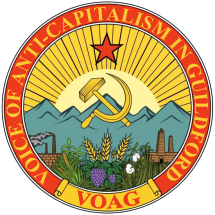How science is telling us all to revolt
Is our relentless quest for economic growth killing the planet? Climate scientists have seen the data – and they are coming to some incendiary conclusions.
Naomi Klein speaks to The VOAG (Well kind of)
In December 2012, a pink-haired complex systems researcher named Brad Werner made his way through the throng of 24,000 earth and space scientists at the Fall Meeting of the American Geophysical Union, held annually in San Francisco. This year’s conference had some big-name participants, from Ed Stone of Nasa’s Voyager project, explaining a new milestone on the path to interstellar space, to the film-maker James Cameron, discussing his adventures in deep-sea submersibles.
But it was Werner’s own session that was attracting much of the buzz. It was titled “Is Earth F**ked?” (full title: “Is Earth F**ked? Dynamical Futility of Global Environmental Management and Possibilities for Sustainability via Direct Action Activism”).
Standing at the front of the conference room, the geophysicist from the University of California, San Diego walked the crowd through the advanced computer model he was using to answer that question. He talked about system boundaries, perturbations, dissipation, attractors, bifurcations and a whole bunch of other stuff largely incomprehensible to those of us uninitiated in complex systems theory. But the bottom line was clear enough: global capitalism has made the depletion of resources so rapid, convenient and barrier-free that “earth-human systems” are becoming dangerously unstable in response. When pressed by a journalist for a clear answer on the “are we f**ked” question, Werner set the jargon aside and replied, “More or less.”
There was one dynamic in the model, however, that offered some hope. Werner termed it “resistance” – movements of “people or groups of people” who “adopt a certain set of dynamics that does not fit within the capitalist culture”. According to the abstract for his presentation, this includes “environmental direct action, resistance taken from outside the dominant culture, as in protests, blockades and sabotage by indigenous peoples, workers, anarchists and other activist groups”.
Serious scientific gatherings don’t usually feature calls for mass political resistance, much less direct action and sabotage. But then again, Werner wasn’t exactly calling for those things. He was merely observing that mass uprisings of people – along the lines of the abolition movement, the civil rights movement or Occupy Wall Street – represent the likeliest source of “friction” to slow down an economic machine that is careening out of control. We know that past social movements have “had tremendous influence on . . . how the dominant culture evolved”, he pointed out. So it stands to reason that, “if we’re thinking about the future of the earth, and the future of our coupling to the environment, we have to include resistance as part of that dynamics”. And that, Werner argued, is not a matter of opinion, but “really a geophysics problem”.
Plenty of scientists have been moved by their research findings to take action in the streets. Physicists, astronomers, medical doctors and biologists have been at the forefront of movements against nuclear weapons, nuclear power, war, chemical contamination and creationism. And in November 2012, Nature published a commentary by the financier and environmental philanthropist Jeremy Grantham urging scientists to join this tradition and “be arrested if necessary”, because climate change “is not only the crisis of your lives – it is also the crisis of our species’ existence”.
Some scientists need no convincing. The godfather of modern climate science, James Hansen, is a formidable activist, having been arrested some half-dozen times for resisting mountain-top removal coal mining and tar sands pipelines (he even left his job at Nasa this year in part to have more time for campaigning). Two years ago, when I was arrested outside the White House at a mass action against the Keystone XL tar sands pipeline, one of the 166 people in cuffs that day was a glaciologist named Jason Box, a world-renowned expert on Greenland’s melting ice sheet.
“I couldn’t maintain my self-respect if I didn’t go,” Box said at the time, adding that “just voting doesn’t seem to be enough in this case. I need to be a citizen also.”
This is laudable, but what Werner is doing with his modelling is different. He isn’t saying that his research drove him to take action to stop a particular policy; he is saying that his research shows that our entire economic paradigm is a threat to ecological stability. And indeed that challenging this economic paradigm – through mass-movement counter-pressure – is humanity’s best shot at avoiding catastrophe.
That’s heavy stuff. But he’s not alone. Werner is part of a small but increasingly influential group of scientists whose research into the destabilisation of natural systems – particularly the climate system – is leading them to similarly transformative, even revolutionary, conclusions. And for any closet revolutionary who has ever dreamed of overthrowing the present economic order in favour of one a little less likely to cause Italian pensioners to hang themselves in their homes, this work should be of particular interest. Because it makes the ditching of that cruel system in favour of something new (and perhaps, with lots of work, better) no longer a matter of mere ideological preference but rather one of species-wide existential necessity.
Leading the pack of these new scientific revolutionaries is one of Britain’s top climate experts, Kevin Anderson, the deputy director of the Tyndall Centre for Climate Change Research, which has quickly established itself as one of the UK’s premier climate research institutions. Addressing everyone from the Department for International Development to Manchester City Council, Anderson has spent more than a decade patiently translating the implications of the latest climate science to politicians, economists and campaigners. In clear and understandable language, he lays out a rigorous road map for emissions reduction, one that provides a decent shot at keeping global temperature rise below 2° Celsius, a target that most governments have determined would stave off catastrophe.
But in recent years Anderson’s papers and slide shows have become more alarming. Under titles such as “Climate Change: Going Beyond Dangerous . . . Brutal Numbers and Tenuous Hope”, he points out that the chances of staying within anything like safe temperature levels are diminishing fast.
With his colleague Alice Bows, a climate mitigation expert at the Tyndall Centre, Anderson points out that we have lost so much time to political stalling and weak climate policies – all while global consumption (and emissions) ballooned – that we are now facing cuts so drastic that they challenge the fundamental logic of prioritising GDP growth above all else.
Anderson and Bows inform us that the often-cited long-term mitigation target – an 80 per cent emissions cut below 1990 levels by 2050 – has been selected purely for reasons of political expediency and has “no scientific basis”. That’s because climate impacts come not just from what we emit today and tomorrow, but from the cumulative emissions that build up in the atmosphere over time. And they warn that by focusing on targets three and a half decades into the future – rather than on what we can do to cut carbon sharply and immediately – there is a serious risk that we will allow our emissions to continue to soar for years to come, thereby blowing through far too much of our 2° “carbon budget” and putting ourselves in an impossible position later in the century.
Which is why Anderson and Bows argue that, if the governments of developed countries are serious about hitting the agreed upon international target of keeping warming below 2° Celsius, and if reductions are to respect any kind of equity principle (basically that the countries that have been spewing carbon for the better part of two centuries need to cut before the countries where more than a billion people still don’t have electricity), then the reductions need to be a lot deeper, and they need to come a lot sooner.
To have even a 50/50 chance of hitting the 2° target (which, they and many others warn, already involves facing an array of hugely damaging climate impacts), the industrialised countries need to start cutting their greenhouse-gas emissions by something like 10 per cent a year – and they need to start right now. But Anderson and Bows go further, pointing out that this target cannot be met with the array of modest carbon pricing or green-tech solutions usually advocated by big green groups. These measures will certainly help, to be sure, but they are simply not enough: a 10 per cent drop in emissions, year after year, is virtually unprecedented since we started powering our economies with coal. In fact, cuts above 1 per cent per year “have historically been associated only with economic recession or upheaval”, as the economist Nicholas Stern put it in his 2006 report for the British government.
Even after the Soviet Union collapsed, reductions of this duration and depth did not happen (the former Soviet countries experienced average annual reductions of roughly 5 per cent over a period of ten years). They did not happen after Wall Street crashed in 2008 (wealthy countries experienced about a 7 per cent drop between 2008 and 2009, but their CO2 emissions rebounded with gusto in 2010 and emissions in China and India had continued to rise). Only in the immediate aftermath of the great market crash of 1929 did the United States, for instance, see emissions drop for several consecutive years by more than 10 per cent annually, according to historical data from the Carbon Dioxide Information Analysis Centre. But that was the worst economic crisis of modern times.
If we are to avoid that kind of carnage while meeting our science-based emissions targets, carbon reduction must be managed carefully through what Anderson and Bows describe as “radical and immediate de-growth strategies in the US, EU and other wealthy nations”. Which is fine, except that we happen to have an economic system that fetishises GDP growth above all else, regardless of the human or ecological consequences, and in which the neoliberal political class has utterly abdicated its responsibility to manage anything (since the market is the invisible genius to which everything must be entrusted).
So what Anderson and Bows are really saying is that there is still time to avoid catastrophic warming, but not within the rules of capitalism as they are currently constructed. Which may be the best argument we have ever had for changing those rules.
In a 2012 essay that appeared in the influential scientific journal Nature Climate Change, Anderson and Bows laid down something of a gauntlet, accusing many of their fellow scientists of failing to come clean about the kind of changes that climate change demands of humanity. On this it is worth quoting the pair at length:
. . . in developing emission scenarios scientists repeatedly and severely underplay the implications of their analyses. When it comes to avoiding a 2°C rise, “impossible” is translated into “difficult but doable”, whereas “urgent and radical” emerge as “challenging” – all to appease the god of economics (or, more precisely, finance). For example, to avoid exceeding the maximum rate of emission reduction dictated by economists, “impossibly” early peaks in emissions are assumed, together with naive notions about “big” engineering and the deployment rates of low-carbon infrastructure. More disturbingly, as emissions budgets dwindle, so geoengineering is increasingly proposed to ensure that the diktat of economists remains unquestioned.
In other words, in order to appear reasonable within neoliberal economic circles, scientists have been dramatically soft-peddling the implications of their research. By August 2013, Anderson was willing to be even more blunt, writing that the boat had sailed on gradual change. “Perhaps at the time of the 1992 Earth Summit, or even at the turn of the millennium, 2°C levels of mitigation could have been achieved through significant evolutionary changes within the political and economic hegemony. But climate change is a cumulative issue! Now, in 2013, we in high emitting industrial nations face a very different prospect. Our ongoing and collective carbon profligacy has squandered any opportunity for the ‘evolutionary change’ afforded by our earlier (and larger) 2°C carbon budget. Today, after two decades of bluff and lies, the remaining 2°C budget demands revolutionary change to the political and economic hegemony” (his emphasis).
We probably shouldn’t be surprised that some climate scientists are a little spooked by the radical implications of even their own research. Most of them were just quietly doing their work measuring ice cores, running global climate models and studying ocean acidification, only to discover, as the Australian climate expert and author Clive Hamilton puts it, that they “were unwittingly destabilising the political and social order”.
But there are many people who are well aware of the revolutionary nature of climate science. It’s why some of the governments that decided to chuck their climate commitments in favour of digging up more carbon have had to find ever more thuggish ways to silence and intimidate their nations’ scientists. In Britain, this strategy is becoming more overt, with Ian Boyd, the chief scientific adviser at the Department for Environment, Food and Rural Affairs, writing recently that scientists should avoid “suggesting that policies are either right or wrong” and should express their views “by working with embedded advisers (such as myself), and by being the voice of reason, rather than dissent, in the public arena”.
If you want to know where this leads, check out what’s happening in Canada, where I live. The Conservative government of Stephen Harper has done such an effective job of gagging scientists and shutting down critical research projects that, in July 2012, a couple thousand scientists and supporters held a mock-funeral on Parliament Hill in Ottawa, mourning “the death of evidence”. Their placards said, “No Science, No Evidence, No Truth”.
But the truth is getting out anyway. The fact that the business-as-usual pursuit of profits and growth is destabilising life on earth is no longer something we need to read about in scientific journals. The early signs are unfolding before our eyes. And increasing numbers of us are responding accordingly: blockading fracking activity in Balcombe; interfering with Arctic drilling preparations in Russian waters (at tremendous personal cost); taking tar sands operators to court for violating indigenous sovereignty; and countless other acts of resistance large and small. In Brad Werner’s computer model, this is the “friction” needed to slow down the forces of destabilisation; the great climate campaigner Bill McKibben calls it the “antibodies” rising up to fight the planet’s “spiking fever”.























 To get a sense of how radical the Bank’s new position is, consider the conventional view, which continues to be the basis of all respectable debate on public policy. People put their money in banks. Banks then lend that money out at interest – either to consumers, or to entrepreneurs willing to invest it in some profitable enterprise. True, the fractional reserve system does allow banks to lend out considerably more than they hold in reserve, and true, if savings don’t suffice, private banks can seek to borrow more from the central bank.
To get a sense of how radical the Bank’s new position is, consider the conventional view, which continues to be the basis of all respectable debate on public policy. People put their money in banks. Banks then lend that money out at interest – either to consumers, or to entrepreneurs willing to invest it in some profitable enterprise. True, the fractional reserve system does allow banks to lend out considerably more than they hold in reserve, and true, if savings don’t suffice, private banks can seek to borrow more from the central bank.



 UCATT met workers who were being paid less than £0.60 pence an hour and who were being paid a little over £50 a week, while being expected to work excessive hours, 6 days a week in temperatures up to 55 degrees in the summer. The levels of poverty pay are especially stark given that Qatar is one of the wealthiest countries in the world.
UCATT met workers who were being paid less than £0.60 pence an hour and who were being paid a little over £50 a week, while being expected to work excessive hours, 6 days a week in temperatures up to 55 degrees in the summer. The levels of poverty pay are especially stark given that Qatar is one of the wealthiest countries in the world. Hundreds of migrant construction workers die in Qatar every year. In the last two years 500 Indian workers have died. Last year 195 Nepalese deaths were recorded 123 of these were recorded as being due to cardiac arrest. UCATT learnt that deceased workers do not receive a post mortem and if the death was recorded as natural causes then no compensation was paid. Mr Murphy added: “The way that migrant workers are treated in Qatar demonstrates that those in power consider their lives to be cheap and expendable.”
Hundreds of migrant construction workers die in Qatar every year. In the last two years 500 Indian workers have died. Last year 195 Nepalese deaths were recorded 123 of these were recorded as being due to cardiac arrest. UCATT learnt that deceased workers do not receive a post mortem and if the death was recorded as natural causes then no compensation was paid. Mr Murphy added: “The way that migrant workers are treated in Qatar demonstrates that those in power consider their lives to be cheap and expendable.”






 The Tory government claimed its intention was to close 20 pits with the loss of 20,000 jobs. When the strike began, Scargill said that the government had a long-term strategy to destroy the industry by closing over 70 pits. Not only did the Government deny this but Ian McGregor, the head of the Coal Board which managed the industry, wrote to every member of the NUM claiming Scargill was deceiving them, and that there were no plans to close any more pits than had already been announced. Cabinet Papers released this year indicate that McGregor did indeed wish to close over 90 pits.
The Tory government claimed its intention was to close 20 pits with the loss of 20,000 jobs. When the strike began, Scargill said that the government had a long-term strategy to destroy the industry by closing over 70 pits. Not only did the Government deny this but Ian McGregor, the head of the Coal Board which managed the industry, wrote to every member of the NUM claiming Scargill was deceiving them, and that there were no plans to close any more pits than had already been announced. Cabinet Papers released this year indicate that McGregor did indeed wish to close over 90 pits. Support for the miners brought together disparate radical groups across Britain, involving more people in a greater intensity of activity, over a lengthier period than any other campaign in the history of the labour movement. There were many violent incidents during the strike, the worst being clashes between striking miners and police at Orgreave. Police charged crowds on horseback with their batons and several people were seriously injured. Watch this documentary which tells some of the story of “The Battle Of Orgreave”
Support for the miners brought together disparate radical groups across Britain, involving more people in a greater intensity of activity, over a lengthier period than any other campaign in the history of the labour movement. There were many violent incidents during the strike, the worst being clashes between striking miners and police at Orgreave. Police charged crowds on horseback with their batons and several people were seriously injured. Watch this documentary which tells some of the story of “The Battle Of Orgreave”


You must be logged in to post a comment.